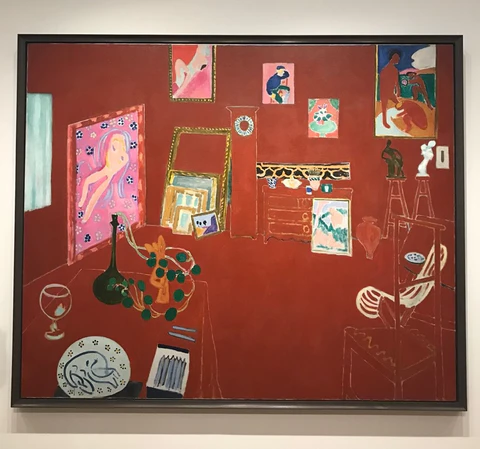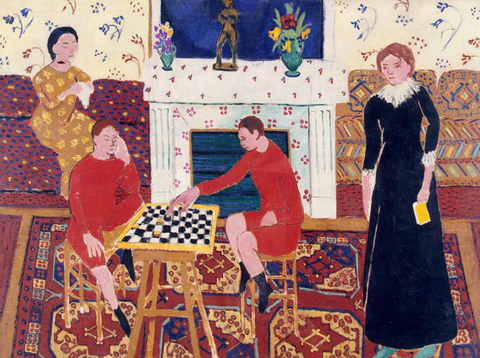The Red Studio, a masterpiece up for sale in the 20th century
Henri Matisse’s The Red Studio (1911), a painting that is now considered not only one of the artist’s masterpieces, but also one of the foundational works of modern art, was first met with indifference. As often happens in the history of artworks, this painting has not always been given the attention and consideration that we give it today and we will here retrace the story of its rise over the decades. This story is only part of the themes that have been touched by the remarkable exhibition titled Matisse: The Red Studio, that has been ongoing from the 10th of May to the 10th of September at the MOMA, the Museum of Modern Art of New York. This exhibition has taken thousands of visitors into one of the most intimate places there are for any artist, the studio. More specifically it has taken viewers into Matisse’s studio and has analyzed every aspect of it. Here, we are going to focus on the painting’s appearance in the art market of the 20th century.
The focus of it is Matisse’s painting, which depicts his workspace in the Parisian suburb of Issy-les-Moulineaux and which is automatically linked to the color red, given that the artist had at some point decided to use this color to represent all the walls, the ceiling, the floor space and the furniture of this room. The other artworks that were at the time kept by Matisse in his studio are also depicted in the painting, as you can see in the picture below.

Henri Matisse, The Red Studio, 1911, showcased at the Matisse: The Red Studio exhibition at the MOMA, May – September 2022
The recently concluded exhibition has gathered in one space all the artworks that you see depicted on the six-foot-tall-by-seven-foot-wide canvas, together again for the first time after being apart since the time The Red Studio was created. Featured are six paintings, three sculptures, and one ceramic by Matisse. The exhibition also focuses on the making of the painting and the creation process followed by Matisse, bringing new elements to the table. But what mostly interests us in this case is the wide range of paintings and drawing that have been showcased on the occasion of the exhibition and that tell the story of the painting within the art market of the 20th century.
The story of this painting is intrinsically linked to one of the most influential patrons of that time, the Russian textile magnate Sergei Ivanovich Shchukin (1854 – 1936), Matisse’s most devoted and courageous patron. Matisse had already realized some of his most famous creations for this same patron, such as Dance (II) and Music. Shchukin was so impressed by Matisse that he wanted more. He asked Matisse to realize three large scale paintings to decorate the staircase of his mansion in Moscow. The last of the trio of paintings is what today we call The Red Studio. The other two are The Pink Studio and The Painter’s Family.
Matisse seldom portrayed his own studio as a way to chronicle the evolution of his style. The painting in question presents a scene that is both realistic and dreamy. It shows the painter’s studio filled with different artworks and objects that are located in a precise place, but that also seem to fluctuate in space because of the use of the Venetian red that somehow eliminates the illusion of space that the painting creates. Once that the painting was done, Matisse reached out to Shchukin and informed the patron that the painting was ready, also including a sketch of it in watercolor after his request. Shchukin’s reply was not too enthusiastic, saying that “the painting must be very interesting” but also telling him that he “preferred [Matisse’s] paintings with figures”, such as The Painter’s Family which was having a great deal of praise in Moscow.

Henri Matisse, The Painter’s Family, 1911, Saint Petersburg, Hermitage Museum (from the exhibition’s catalogue, p. 47)
The rejected painting, which was at the time known as the Panneau Rouge (i.e. the red panel), would make its first appearance in public in the occasion of London’s Second Post-Impressionist Exhibition organized by Roger Fry and presented at the Grafton Galleries in 1912. There, The Red Studio, along with seven other paintings by Matisse, had been noticed by two American artists, Arthur B. Davies and Walt Kuhn that were looking for material for an upcoming exhibition set in New York, the International Exhibition of Modern Art. Matisse’s work thus traveled to New York and was showcased in the 1913 exhibition at the Armory Show, and then to Chicago for the second staging of the exhibition at the Art Institute of Chicago. There Matisse’s painting was titled The Red Panel and though it was praised in the press, it had a very hard time finding a buyer. One would have to wait until 1927, nearly sixteen years after its creation, for a buyer to finally come forward. The buyer was David Pax Tennant, the owner of the Gargoyle club in London, where the painting hung from 1927 to 1938. The Red Studio was sold at the price of 806 pounds.

Henri Matisse’s The Red Studio at the Gargoyle Club, London 1930s
(from the exhibition’s catalogue, p. 108)
In 1938, the painting went back on the market, and it first ended up at the Redfern Gallery, only to be bought, probably around 1945, by the Swiss-born art dealer Georges Frédérik Keller who lived in New York. Back in New York, the painting, now titled The Artist’s Studio, had been available for view at the Bignou Gallery and would soon capture the attention of the Alfred H. Barr Jr., the director of the MOMA and of Stephen C. Clark, chairman of the Museum’s board of trustees. The breakthrough occurred in 1948, when Keller informed Barr that the painting was on sale for $35,000. After some negotiation, the painting was finally sold to the Museum of Modern Art in New York at the price of $29,000.
This is the story of how The Red Studio by Henri Matisse finally got the spot it deserved, after an intricate and complex first years of life.
Sources:
Matisse: The Red Studio, exhibition catalogue edited by Ann Temkin and Dorthe Aagesen, 2022, The Museum of Modern Art, New York / SMK – National Gallery of Denmark, Copenhagen

